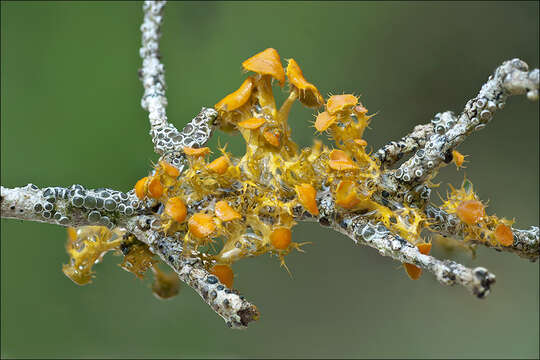Teloschistes-chrysophthalmus_1

Description:
Teloschistes chrysophthalmus (L.) Th. Fr., syn: Xanthoanaptychia chrysophthalma (L.) S.Y. Kondr. & Krnefelt, Niorma chrysophthalma (L.) S.Y. Kondr., Krnefelt, Elix, A. Thell, M.H. Jeong & HurEN: Gold-eye lichen, Golden-eye, DE: Goldflechte, GoldaugenflechteSlo.: ?Dat.: May 04. 2019Lat.: 45.07642 Long.: 14.43666Code: Bot_1191/2019_DSC5058 Habitat: Sub-Mediterranean macchia; calcareous, skeletal ground, slightly inclined hill slope, west aspect; dry, sunny place; average precipitations ~ 1.000 mm/year, average temperature 13-14 deg C, elevations 65 m (215 feet), Sub-Mediterranean phytogeographical region. Substratum: small (diameter of less than 8 mm), dead but also alive twigs of Phillyrea latifolia and less frequent of young, bushy Fraxinus ornus branches.Place: West island Krk, west-southwest of village Brzac, along the trail to the sea shore, Kvarner archipelago, Rijeka region, Croatia EC. Comment: From the beginning of my interest for lichens, that's about 10 years ago, I've been impressed by the beautiful picture of Teloschistes chrysophthalmus in the equally beautiful book Brodo, Sharnoff, S.Sharnoff (2001) Lichens of North America (Ref.2). The specimen pictured on book's front cover seemed to me miraculous, from 'tropical' character and obviously rare. I have had little hope once to find it. Actually, Teloschistes chrysophthalmus is a widely scattered lichen present on north and south earth hemisphere (except in Asia and Antarctica) but in very localized areas and indeed rare at least in Europe. Literature states: " very rare " in England (Ref.:1), " now (2005) probably already extinct from Britain" (Ref.4): " not documented from Check Republic" (Ref.6), "extremely rare" in Italy (Ref.:9); "extinct from Germany, Baden-Wrttemberg already at the beginning of 19. century" (Ref.: 3). The species have been eliminated over many former places by habitat destruction and air pollution. But, on some places it is recently recolonizing its former distribution areas, like in south England (Ref.:12).Presently there is no records of Teloschistes chrysophthalmus in the Boletus Informaticus Database for Slovenia (Ref.: 5). But, Ref.:11. states its presence in subalpine and Dinaric phytogeographical regions of the country. Records from Sub-Mediterranean region of Croatia along Adriatic Sea shore also exist (Ref. 8. substratum Spartium junceus and Ref. 9. substratum Quercus pubescens). However, a relatively recent lichen survey of the island Krk does not list this species (Ref.: 10). The closest find seems to be a single, more than hundred years old find in Kvarner bay littoral region next to the island Krk (Ref.:13). Eventually these pictures show the first documented observation of this species on the island Krk.The find was, at the first moment, a small disappointment for me. Lichen tufts in dry state were quite inconspicuous, of muddy orange brown color and much, much smaller than their picture in my mind (based on Sharnoff's beautiful macro picture). However, when looked through hand lens and in moist state they unfold their beauty incredibly. The bushy tufts were many, on many bushes along the narrow trail through macchia, altogether more than 100 individuals. They were mostly about 1 cm in diameter and 5-10 mm high, many were smaller and only some up to 2 cm across. All of them strictly inhabited small, dead or alive branches and twigs.Ref.:(1) C.W.Smith, et all, The lichens of Great Britain and Ireland, The British Lichen Society (2009), p 875.(2) I.M. Brodo, S.D. Sharnoff, S.Sharnoff, Lichens of North America, Yale Uni. Press (2001), p 674.(3) V. Wirth, Die Flechten Baden-Wrttembergs, Teil. 2., Ulmer (1995), p 674.(4) F.S. Dobson, Lichens, The Richmonds Publishing Ca. LTD (2005), p 421.(5) N. Ogris (ed.), Boletus informaticus, Slovenian Forestry Institute www.zdravgozd.si/bi_index.aspx (accessed May 12. 2019)(6) www.preslia.cz/P082Lis.pdf (accessed May 12. 5.2019)(7) dryades.units.it/italic/index.php?procedure=taxonpage&... (accessed May 13. 5.2019)(8) S.N. Christensen and E.S. Hansen, Lichens from Croatia, Acta Bot. Croat. 53, 101113, (1994) www.researchgate.net/publication/304570397_Lichens_from_C... (accessed May 13. 5.2019)(9) S.N. Christensen, 1988: Contribution to the lichen flora of Istria, Yugoslavia. Acta Bot. Croat. (1988), 47, pp 127-134 (10) S. Ozimec, T. Florian, A. Opaak, Z. Pupkadija & J. Topi, Lichen mycota from the Island of Krk (northern Adriatic sea, Croatia), Natura Croatica, (2009), 18, 2, pp 367-385; available at: www.researchgate.net/publication/288371945_Lichen_mycota_... (accessed May 14. 2019)(11) U. Suppan, J. Prugger, H. Mayrhofer, Lichen biodiversity in Slovenia, Catalogue of the lichenized and lichenicolous fungi of Slovenia, members.chello.at/johannes.pruegger/uni/slovenia/ (accessed May 14. 2019)(12) N.A Sanderson, History & Ecology of Goldeneyes Teloschistes chrysophthalmus in England, Wessex Lichen Group; wessexlichengroup.org/conservation_ecology/teloschistes_c... (accessed May 15. 2019)(13) O. Sinia, Diversity and ecology of epiphytic and terricolous lichen mycota in Gorski kotar and Kvarner littoral (Croatia), Acta biologica Slovenica (2011), 54, 1, pp 15-41; available at: www.dlib.si/stream/URN:NBN:SI:DOC-O3D5MVXX/014c009b-12de-... (accessed May 15. 2019)
Included On The Following Pages:
- Life (creatures)
- Cellular (cellular organisms)
- Eukaryota (eukaryotes)
- Opisthokonta (opisthokonts)
- Nucletmycea
- Fungi (mushrooms, lichens, molds, yeasts and relatives)
- Dikarya
- Ascomycota (sac fungi)
- Lecanoromycetes
- Teloschistales
- Teloschistaceae
- Teloschistes (teloschistes lichen)
- Teloschistes chrysophthalmus (teloschistes lichen)
This image is not featured in any collections.
Source Information
- license
- cc-by-nc-sa
- copyright
- Amadej Trnkoczy
- photographer
- Amadej Trnkoczy
- original
- original media file
- visit source
- partner site
- Flickr Group
- ID


